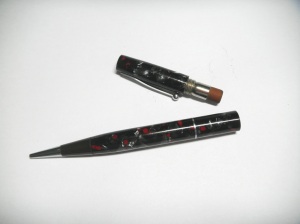The other night I was cleaning a vintage fountain pen-and-pencil set that I wanted to sell. It was a 1930s Marine Green
Sheaffer Balance mismatched
pair - while the fountain pen was the standard length, the propelling
pencil of the same pattern was shorter, sized for a vest pen. (I
originally acquired them together, from the
Fountain Pen Network Classifieds
section a few years ago. Since then I was able to find a White Dot
version in the same celluloid, so it was time to pass this pair on.)
I
find that for some enthusiasts, the vintage pencil is an afterthought.
Not many actually use the pencils as much as they would the fountain
pens. Sellers sometimes break up sets in order to more easily sell the
items. Maybe that's how my little vest pencil got orphaned, and later
matched up with the wrong size pen. Some people, on the other hand, end
up collecting vintage pencils for their beautiful celluloid
(unblemished by latex sacs or staining ink).
Propelling pencils
are writing tip-loading twist action pens. To expel old lead, you twist
the pencil clockwise to push the lead upwards and out. Then you twist
the other way until the metal pin that pushes the lead is fully
retracted. You place the appropriate size lead in through the pen's
nose cone and press the protruding tip onto the paper to make sure the
lead is securely lodged. If you're not sure how to load your pencil,
the blog
Dave's Mechanical Pencils gives instructions, according to brand and era.
It
was while learning how to refill the pencil that I realized it
contained the wrong size lead. It was a 0.9mm lead that kept falling
out. I cleaned out residue from the nose cone with a straight pin and
tried some vintage Scripto 1.1mm lead that a friend gave me. It was a
perfect fit! By the end of that exercise I realized I had fallen in love
with the tiny pencil and just decided to keep it.
Richard Binder mentions that vintage Sheaffers and Parkers usually use 0.9mm leads, but not in
this case.
Pendemonium is
another good source for vintage leads (the site navigation is not that
intuitive, but go to Pen Repairs Supplies and select Pencil Leads). The
most common sizes sold locally are 0.5mm and 0.7mm leads for modern
mechanical pencils, but 0.9mm is available if you look for Japanese or
Korean pencil brands (I use MonAmi).

I
couldn't resist checking out the Waterman Ideal No. 3 propelling pencil
that I received as a gift last January. I took it apart and discovered
that the cap end unscrews to expose the eraser. I heard pencil lead
rattling inside the eraser tube, so I pulled the eraser tube out and
found a stash of short 1.1mm leads! The nose cone twists to propel the
lead, but there wasn't much traction, so I lined the mechanism with a
bit of latex and gently turned it with my pliers. I'll see later if a
layer of dried shellac can thicken the diameter of the brass tube and
provide traction for the nose cone (no, I'm not gluing them together).
I'm not using the vintage eraser on this one - I have my favorite modern
eraser (Staedtler Mars Plastic) for that.
For most daily use my
1940s Sheaffer Crest pencil with 0.9mm lead is pretty good. It's part
of a set, too. I do have a couple of other modern plastic mechanical
pencils, but right now they're not getting that much attention. The
pretty vintage celluloid and the solid build appeal to me. It's not a
collecting direction I'll be taking, but I sure do appreciate the fact
that they're decades old and still work!
To learn more about vintage pencils, check out Jon Veley's
The Leadhead's Pencil Blog. Jon Veley also wrote the book
The Catalogue of American Mechanical Pencils and maintains
The Mechanical Pencil Online Museum.

0 Comments:
Post a Comment